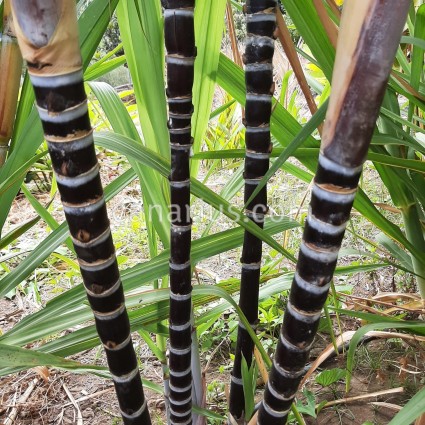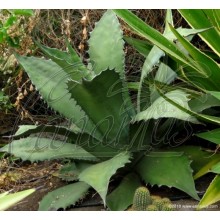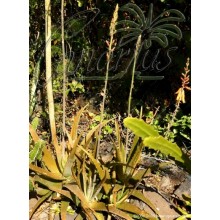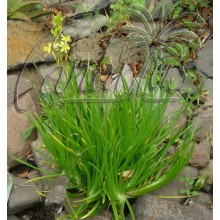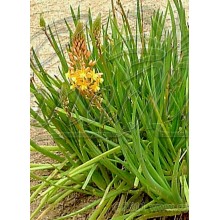Saccharum officinarum 'Badila'
Old, classic sugarcane, with purple-black internodes. It is a great choice for the family orchard because of its thick, compact growth and its beauty. Badila's juice is darker in colour too, It grows erect, straight, short and thick black stalks.
Neu
This is an old, classic sugarcane, with purple-black internodes. Badila is a great choice for the family orchard because of its thick, compact growth and its beauty. Its juice is darker in colour too. It grows erect and straight canes, with short and thick dark stalks. Saccharum Badila became a commercial variety in the early stages of sugarcane industry and then it was abandoned. But its genes survived as it became an ancestor to many modern sugarcane hybrids, because of its short growth stature! This cultivar is also widespread in SE Asia in family backyards, and this is why many people call it Asian Black.
What are the differences between the Asian black cane Badila and the Hawaiian black cane Ko honua ula? In Badila, leaves are green and canes are rather short and straight and much thicker, even three times in diameter. In Ko Honua Ula, leaves are green to dark purple and canes are slender and often arching, developing aerial roots in their lower nodes. Both cultivars will build canes with an incredible black colour with whitish waxy nodes, displaying an ornamental "zebra pattern". Modern research suggest that both of them originated in Papua New Guinea, which is the centre of domestication of sugar canes. Then the "Asian" cane was spread westwards while the "Hawaiian" was spread Eastwards.
All these "old" cultivars of that we grow are called "noble canes", as they are clones of "true" Saccharum officinarum, selected in New Guinea from the wild Saccharum robustum and then spread to SE Asia and the Pacific Islands. All sugarcanes were "noble canes" until the early XX century, when they were hybridized with Saccharum spontaneum, in order to increase sugar production and resistance. Hybrids replaced noble canes but now they are loved and planted for family use, because of their superior taste and ease of chewing.
Sugar Canes are 3-5 m tall tropical grasses that produces most of the world sugar. Saccharum officinarum grows in tropical to warm mediterranean climates. Canes can be peeled and eaten at any moment, they are best after blooming. Sugar cane is very fast growing in hot summer weather. Water and fertilize abundantly in summer! They bloom in late autumn or winter, and when they do it, they have the highest sugar contect. They are all hardy to light and short frosts, but some cultivars do better than others in cooler locations. If frosts are expected, protect the base with mulch and more .
Canarius offers a super thick 50 cm ready-to-sprout cutting. Cuttings are the best way to reproduce sugar cane, because they root easily and will give a plant exactly like the original mother plant. Our cuttings can be used as they are or they can be split in two or three smaller cuttings. They root better in a sandy and draining soil. Keep them moist and warm above 17 C. The best rooting temperature is 20-30 C.
Notice to the customers in the USA: We canot ship this species because it is not allowed in your country.
What are the differences between the Asian black cane Badila and the Hawaiian black cane Ko honua ula? In Badila, leaves are green and canes are rather short and straight and much thicker, even three times in diameter. In Ko Honua Ula, leaves are green to dark purple and canes are slender and often arching, developing aerial roots in their lower nodes. Both cultivars will build canes with an incredible black colour with whitish waxy nodes, displaying an ornamental "zebra pattern". Modern research suggest that both of them originated in Papua New Guinea, which is the centre of domestication of sugar canes. Then the "Asian" cane was spread westwards while the "Hawaiian" was spread Eastwards.
All these "old" cultivars of that we grow are called "noble canes", as they are clones of "true" Saccharum officinarum, selected in New Guinea from the wild Saccharum robustum and then spread to SE Asia and the Pacific Islands. All sugarcanes were "noble canes" until the early XX century, when they were hybridized with Saccharum spontaneum, in order to increase sugar production and resistance. Hybrids replaced noble canes but now they are loved and planted for family use, because of their superior taste and ease of chewing.
Sugar Canes are 3-5 m tall tropical grasses that produces most of the world sugar. Saccharum officinarum grows in tropical to warm mediterranean climates. Canes can be peeled and eaten at any moment, they are best after blooming. Sugar cane is very fast growing in hot summer weather. Water and fertilize abundantly in summer! They bloom in late autumn or winter, and when they do it, they have the highest sugar contect. They are all hardy to light and short frosts, but some cultivars do better than others in cooler locations. If frosts are expected, protect the base with mulch and more .
Canarius offers a super thick 50 cm ready-to-sprout cutting. Cuttings are the best way to reproduce sugar cane, because they root easily and will give a plant exactly like the original mother plant. Our cuttings can be used as they are or they can be split in two or three smaller cuttings. They root better in a sandy and draining soil. Keep them moist and warm above 17 C. The best rooting temperature is 20-30 C.
Notice to the customers in the USA: We canot ship this species because it is not allowed in your country.
| Anbau | Innenanbau |
| Herkunft der Arten | Oceanien |
| Präsentation | Stecklinge |
| Maximale Größe | 250cm-300cm |
| Botanische Familie | Poaceae |
| Lichtbedürfnis | Sonne |
| Mindesttemperatur im Winter | 0 ºC bis 15 ºC |
| Blütezeit | Herbst |
| Pflanzentyp | krautartig |
| Farbe | Grün |
| Farbe | Orange |
| Farbe | Gelb |
| Pflegebedürfnis | Blumentopf |
| Wuchsform | Rhizomen |
-
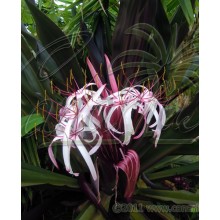
Crinum procerum splendens
29,80 € -
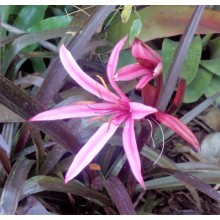
Crinum x Menehune
24,60 €















